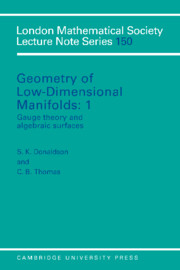Book contents
- Frontmatter
- Contents
- Contributors
- Names of Participants
- Introduction
- Acknowledgments
- PART 1 FOUR-MANIFOLDS AND ALGEBRAIC SURFACES
- PART 2 FLOER'S INSTANTON HOMOLOGY GROUPS
- 6 Instanton homology, surgery and knots
- 7 Instanton homology
- 8 Invariants for homology 3-spheres
- 9 On the Floer homology of Seifert fibered homology 3-spheres
- 10 Za-invariant SU(2) instantons over the four-sphere
- PART 3 DIFFERENTIAL GEOMETRY AND MATHEMATICAL PHYSICS
10 - Za-invariant SU(2) instantons over the four-sphere
Published online by Cambridge University Press: 16 February 2010
- Frontmatter
- Contents
- Contributors
- Names of Participants
- Introduction
- Acknowledgments
- PART 1 FOUR-MANIFOLDS AND ALGEBRAIC SURFACES
- PART 2 FLOER'S INSTANTON HOMOLOGY GROUPS
- 6 Instanton homology, surgery and knots
- 7 Instanton homology
- 8 Invariants for homology 3-spheres
- 9 On the Floer homology of Seifert fibered homology 3-spheres
- 10 Za-invariant SU(2) instantons over the four-sphere
- PART 3 DIFFERENTIAL GEOMETRY AND MATHEMATICAL PHYSICS
Summary
INTRODUCTION
The purpose of this article is to give a classification of invariant SU(2)-instantons on S4 for some equivariant SU(2)-bundles over S4 and to give some applications. We use the term instanton for anti-self-dual connection here. It is well known that the moduli spaces of SU(2)-instantons on the standard four sphere S4 are smooth manifolds. When a group Г acts on S4 isometrically and P is a Г-invariant SU(2)- bundle, the moduli space M(P) of Г-invariant instantons on P is defined as the quotient of the space of Г-invariant instantons divided by the Г-equivariant gauge transformations. Then M(P) has a natural smooth structure as well. Instantons on S4 are classified by the ADHM-construction [2] or the monad description [5], so, in principle, we have a description of invariant instantons. On the other hand, for some group actions the invariant instantons have some geometric interpretation: M. F. Atiyah pointed out as an important example that when Г is the rotations around S2 in S4, the Г-invariant instantons are interpreted as hyperbolic monopoles [1]. In this article we consider subgroups of the maximal torus of SO(4) as F and Г-equivariant SU(2)-bundles over S4 for which the moduli spaces of invariant instantons are one-dimensional, in particular when Г is a finite cyclic group Za of order a.
- Type
- Chapter
- Information
- Geometry of Low-Dimensional Manifolds , pp. 161 - 174Publisher: Cambridge University PressPrint publication year: 1991
- 3
- Cited by

